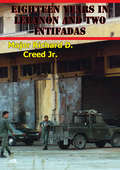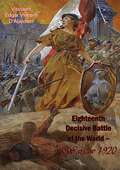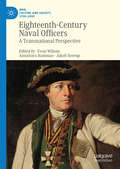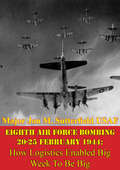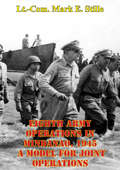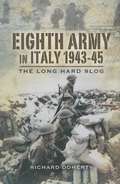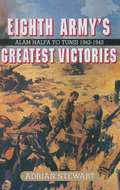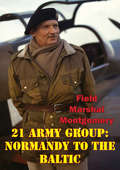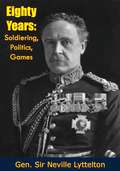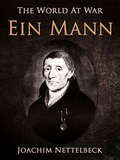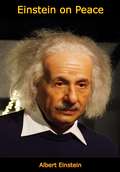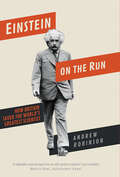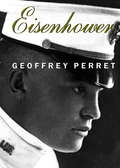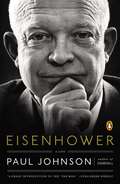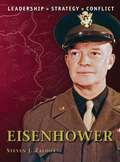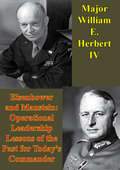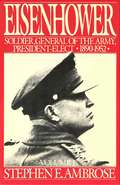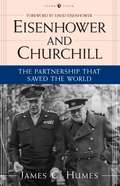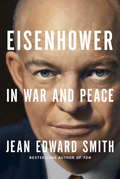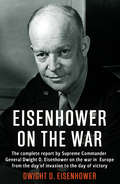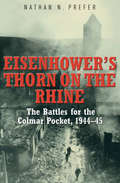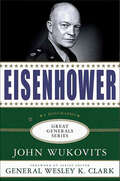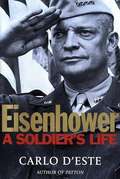- Table View
- List View
Eighteen Years In Lebanon And Two Intifadas: The Israeli Defense Force And The U.S. Army Operational Environment
by Major Richard D. Creed Jr.This monograph determined that the tactical and strategic experience of the Israeli Defense Force (IDF) since 1981 was relevant to the future operational environment of the U.S. Army. The IDF's experiences are relevant because the Israeli Army was similarly equipped and organized to the heavy units in the U.S. Army, both then and now. Israel faced a similar full spectrum threat, and the IDF had to adapt to enemies who switched to asymmetric methods in order to overcome Israel's conventional military superiority. The IDF of 1981 paralleled the U.S. Army of the 2000 in many ways. It was a mechanized heavy force designed to conduct operations against a Soviet armed and equipped enemy. It fought and defeated some of those enemies decisively eight years previously. Beginning with the invasion of Lebanon (Operation "Peace for Galilee"), the IDF discovered that there were no peer competitors willing to fight it on its own terms. The nature of war changed for the IDF in sometimes unexpected ways, and it struggled to adapt to its changing operational environment. The IDF operational environment became much more complicated, because while it retained the old threats in the form of its Arab neighbors, it added sustained guerrilla war and civil insurrection.
Eighteenth Decisive Battle of the World – Warsaw 1920
by Viscount Edgar Vincent D'AbernonAfter the cataclysmic events of the First World War officially ended on the Western Front in 1918, the Democratic Western Powers were still faced with the fallout of the struggle for power in Russia. There was a very real chance that the Communist contagion would transfer across the borders of Russia to Eastern Europe, as it would do some two decades later. Viscount Edgar Vincent D'Abernon was head of the Interallied Mission to Poland and was eye-witness to the struggle in Poland that culminated in the battle for Warsaw that saw the red tide turned back.“The 18th most decisive battle in history...Had the Battle of Warsaw ended with a Bolshevik victory, it would have been a turning point in the history of Europe; as there is no doubt that with the fall of Warsaw, Central Europe would have been left open to Communist propaganda and Soviet invasion.
Eighteenth-Century Naval Officers: A Transnational Perspective (War, Culture and Society, 1750 –1850)
by Evan Wilson AnnaSara Hammar Jakob SeerupThis book surveys the lives and careers of naval officers across Europe at the height of the age of sail. It traces the professionalization of naval officers by exploring their preparation for life at sea and the challenges they faced while in command. It also demonstrates the uniqueness of the maritime experience, as long voyages and isolation at sea cemented their bond with naval officers across Europe while separating them from landlubbers. It depicts, in a way no previous study has, the parameters of their shared experiences—both the similarities that crossed national boundaries and connected officers, and the differences that can only be seen from an international perspective.
Eighth Air Force Bombing 20-25 February 1944: How Logistics Enabled Big Week To Be Big
by Major Jon M. Sutterfield USAFEighth Air Force (8AF) conducted the US's first thousand-bomber raids against Germany in February 1944--recorded in history as Big Week. Until that time the USAAF was not able to concentrate such firepower on the enemy in such a short period of time. It took much effort to make Big Week "big" covering the spectrum of planning and execution activities dating back to the end of World War I that were adapted and flexed to be successful in a different context. Indeed, the depth and breadth of the preparations required to successfully execute Big Week on the scale intended is deserving of a closer examination.Leadership from President Roosevelt to first line supervisors influenced 8AF logistics before February 1944. Major General Hugh J. Knerr was the one man that stood out as the champion of USAAF logistics. He influenced the concept of logistical operations in the ETO and, more specifically, put logistics on a level of importance equal to that of operations within the United States Strategic Air Forces (USSTAF). He synchronized logistics with operations and strove for constant improvement by making organizational and process changes aimed at increasing logistical responsiveness, effectiveness, and efficiency.The British provided tremendous host nation support including construction of new airfields, skilled and unskilled labor support, supply items, and transportation. The British host nation support 8AF received far surpassed what a cursory review of World War II history leads one to believe and serves as a model for US-led coalition operations in the 21st century. The US Merchant Marine and US Navy provided sealift of goods from the stateside depots to the theater. The US Army provided supply support of common items and Air Service Command (ASC) provided technical and supply support. Last, but not least, both civil servants and civilian contractors provided depot maintenance and in-theater technical support.
Eighth Army Operations In Mindanao, 1945 A Model For Joint Operations
by Colonel Joseph G. Terry Jr.While amphibious operations have historically straddled single service prerogatives and had been conspicuously avoided prior to World War II, in the Pacific area of operations during World War II such operations were abundant, decisive and generally regarded as models of joint service cooperation. Under the legendary General Douglas MacArthur, the Philippine Campaign in 1944-45 was especially noteworthy as a model of a single flexible strategy, unity of command, and joint service cooperation. Yet forty-five years later, our national military experience in joint planning and operations has appeared to regress. The recent Goldwater-Nichols Department of Defense Reorganization Act of 1986, however, has elevated service interest in joint planning and operations. This study briefly discusses the Mindanao Operation (March-July 1945), one of several operations within the Philippine Campaign. The study focuses on the impact of existing joint doctrine on the planning, coordination and execution of operations and evidence of joint action to solve some specific and unique challenges encountered within the operation. A summary of the Mindanao operation and appropriate comments on its applicability as a model for today's joint operations complete this study.
Eighth Army in Italy, 1943-45: The Long Hard Slog
by Richard DohertyEighth Army, Britain's most famous field army of the twentieth century, landed in Italy in September 1943 and fought continously until the defeat of the Germans in early-May 1945. This book studies the experience of Eighth Army in the Italian campaign, examining how a force accustomed to the open spaces of North Africa adjusted to the difficult terrain of Italy where fighting became much more a matter for the infantry than for the armour. It also compares the qualities of the commanders of Eighth Army in Italy: Montgomery; Leese and, finally, McCreery. The book uses official records at various levels, personal accounts - some never before published - and published material to present a picture of an army that, although defined as British, was one of the war's most cosmopolitan formations. Its soldiers came from the UK, Canada, India, Ireland, Nepal, New Zealand, Poland and South Africa as well as from Palestine - the Jewish Brigade - and from Italy itself.
Eighth Army's Greatest Victories: Alam Halfa to Tunis 1942–1943
by Adrian TurnerTo read many accounts, it would appear that the Eighth Army's victory at El Alamein was quickly followed by its triumphant arrival at Tunis. Adrian Turner, the experienced authority on the period, redresses the imbalance by describing brilliantly the progress of this legendary fighting force and describing the ferocity of such battles as that for the Mareth Line. The author deftly handles strategic level thinking, the tactical battles and individual contributions. Aviation readers will be thrilled by recognition of the Desert Air Force's contribution, too often neglected.
Eighth Army: El Alamein To The River Sangro [Illustrated Edition] (Memoirs Of Field Marshal Montgomery #2)
by Field Marshal Viscount Bernard Law Montgomery of Alamein KG GCB DSO PC[Illustrated with 16 highly detailed maps of the actions]Field Marshal Montgomery commanded the Eighth Army from 13th August 1942 until the 31st December 1943, and the 21st Army Group from 1st January 1944 until the German surrender on the 5th May, 1945. Whilst in command of the British Army of the Rhine, in occupation of Germany, shortly after the end of the Second World War Montgomery set out to record the exploits and victories of the troops under his command.Both this volume and its companion volume, Normandy to the Rhine, are superb examples of military history as presented by one of the greatest generals to command victorious armies in the field. The texts are taken from his personal war diaries and are distinguished by his incisive style. The whole strategy and course of these two campaigns are presented to the reader with great clarity and accuracy.El Alamein to the River Sangro is as he himself writes '... an authoritative account of the activities of the Eighth Army in the days of its greatest, successes'. El Alamein was the turning point in the war: from that momentous battle the tide against Germany turned. During the time the Eighth Army was commanded by Monty it lost not a single action, and when Monty was transferred to Europe in December 1943, Winston Churchill wrote to him: 'The immortal march of the Eighth Army from the gates of Cairo along the African shore, through Sicily, has now carried its ever victorious soldiers far into Italy towards the gates of Rome. The scene changes and vastly expands. A great task accomplished gives place to a greater, in which the same unfailing spirit will win for all true men a full and glorious reward.'
Eighty Years: Soldiering, Politics, Games
by Gen. Sir Neville LytteltonBegun in 1914 and first published in 1927, these are the memoirs of General Sir Neville Gerald Lyttelton, a British Army officer who served, in the Sudan, Ireland and most notably the Second Boer War. He draws upon his reminiscences with the aid of correspondence with various members of his family and from his diary entries dating back as far as 1873.A fascinating military history read!
Ein Mann: Des Seefahrers Und Aufrechten Bürgers Joachim Nettelbeck Wundersame Lebensgeschichte (The World At War)
by Joachim NettelbeckJoachim Christian Nettelbeck (* 20. September 1738 in Kolberg; 29. Januar 1824 ebenda) war ein durch seine Rolle bei der Verteidigung Kolbergs im Jahre 1807 und seine Autobiographie bekannter deutscher Volksheld. Als Elfjähriger durfte Nettelbeck auf dem Schiff seines Onkels ausnahmsweise nach Amsterdam mitreisen. Dort schlich er sich im Hafen an Bord eines holländischen Ozeanseglers und kam erst auf offener See wieder zum Vorschein. Das Schiff war ein Sklavenhändler und befuhr das Dreieck Westeuropa - Westafrika - Westindien - Westeuropa. Nach neunmonatiger Reise besuchte Nettelbeck bis zur Konfirmation wieder die Schule in Kolberg. Danach begann er eine Seemannsausbildung, zunächst als Schiffsjunge auf Ost- und Nordseefahrern. (Auszug aus Wikipedia)
Eine globale Geschichte von Kriegsführung und Technologie: Von Schleudern zu Robotern
by Kaushik RoyDieses Buch behandelt die globale Geschichte von Technologie, Kriegsführung und Staatenbildung vom Steinzeitalter bis zum Informationszeitalter. Unter Verwendung einer Kombination von Top-Down- und Bottom-Up-Methoden untersucht es sowohl zwischenstaatliche als auch innerstaatliche Konflikte mit einem Schwerpunkt auf eurasischer Technologie und Kriegsführung. Es zeigt, wie menschliches Handeln und strukturelle Faktoren miteinander verflochten sind und ein komplexes Geflecht von Technologie und Kriegsführung schaffen. Es erforscht auch das Zusammenspiel zwischen technologischen und nicht-technologischen Faktoren, um die Entwicklung der Kriegsführung von ihren Anfängen bis heute zu veranschaulichen, und argumentiert, dass die Interaktionen zwischen zivilen und militärischen Sektoren den Einsatz von Technologie in der Kriegsführung geprägt haben. Aufgrund ihres Umfangs und ihrer Tiefe ist es eine wertvolle Ressource für Forscher in Bereichen wie Weltgeschichte, Geschichte von Wissenschaft und Technologie, Geschichte von Kriegsführung und Imperialismus sowie Internationale Beziehungen.
Einstein on Peace: His Private Thoughts And Public Stands On Nationalism, Zionism, War, Peace, And The Bomb
by Albert Einstein Otto Nathan“Einstein was not only the ablest man of science of his generation, he was also a wise man, which is something different. If statesmen had listened to him, the course of human events would have been less disastrous than it has been.”This verdict, from the Preface by Bertrand Russell, sums up the importance of this first collection of Albert Einstein’s writings on war, peace, and the atom bomb. In this volume, thanks to the Estate of Albert Einstein, the complete story is told of how one of the greatest minds of modern times worked from 1914 until 1955 on the problem of peace. It is a fascinating record of a man’s courage, his sincerity, and his concern for those who survive him.This book is also a history of the peace movement in modern times. Here are letters to and from some of the most famous men of his generation, including the correspondence between Einstein and Sigmund Freud on aggression and war, and the true story of his famous letter to President Roosevelt reporting the theoretical possibility of nuclear fission. It is the living record of more than forty years of Einstein’s untiring struggle to mobilize forces all over the world for the abolition of war and the creation of a supranational organization to solve conflicts among nations.
Einstein on the Run: How Britain Saved the World's Greatest Scientist
by Andrew RobinsonA "highly readable" account of the role Britain played in Einstein's life—by inspiring his teenage passion for physics and providing refuge from the Nazis (The Wall Street Journal).In late 1933, Albert Einstein found himself living alone in an isolated holiday hut in rural England. There, he toiled peacefully at mathematics, occasionally stepping out for walks or to play his violin. But how had Einstein come to abandon his Berlin home and go “on the run”?This lively account tells the story of the world’s greatest scientist’s time in Britain for the first time, showing why the country was the perfect refuge for Einstein from rumored assassination plots by Nazi agents. Young Einstein’s passion for British physics, epitomized by Newton, had sparked his scientific development around 1900. British astronomers had confirmed his general theory of relativity, making him internationally famous in 1919. Welcomed by the British people, who helped him campaign against Nazi anti-Semitism, he even intended to become a British citizen. So why did Einstein then leave Britain, never to return to Europe?“A vivid look at how the U.K. affected the German-born physicist’s life and thinking.” —Publishers Weekly“A marvelous job of pulling new and interesting material out of the Einstein archives . . . I suspect that even readers who have devoured many books about Einstein and are already familiar with his interactions with the English . . . will find much to learn and enjoy.” —Metascience Journal“Robinson has that rare knack for presenting a near-encyclopedic volume of historical information, anecdotes and contemporaneous accounts in a thoroughly delightful fashion.” —Physics WorldIncludes photographs and illustrations
Eisenhower
by Geoffrey PerretDrawing on newly available material, including Eisenhower's papers and diaries, author and military historian Geoffrey Perret offers a comprehensive portrait of the life, military exploits, political life, and presidency of Dwight D. Eisenhower (1890-1969). He covers several controversies including an alleged dalliance, Eisenhower's break with MacArthur in 1939, his opinion of Nixon, and his role in McCarthy's activities. Annotation c. Book News, Inc., Portland, OR (booknews.com)
Eisenhower
by Paul JohnsonAcclaimed historian Paul Johnson's lively, succinct biography of Dwight D. Eisenhower explores how his legacy endures today In the rousing style he's famous for, celebrated biographer Paul Johnson offers a fascinating portrait of Dwight D. Eisenhower, focusing particularly on his years as a five-star general and his time as the thirty-fourth President of the United States. Johnson chronicles President Eisenhower's modest childhood in Kansas, his college years at West Point, and his rapid ascent through the military ranks, culminating in his appointment as Supreme Commander of the Allied Forces in Europe during World War II. Beginning when Eisenhower assumed the presidency from Harry Truman in 1952, Johnson paints a rich portrait of his two consecutive terms, exploring his volatile relationship with then-Vice President Richard Nixon, his abhorrence of isolationism, and his position on the Cold War, McCarthyism, and the Civil Rights Movement. Johnson notes that when Eisenhower left the White House at age 70, reluctantly passing the torch to President-elect John F. Kennedy, he feared for the country's future and prophetically warned of the looming military-industrial complex. Many elements of Eisenhower's presidency speak to American politics today, including his ability to balance the budget and skill in managing an oppositional Congress. This brief yet comprehensive study will appeal to biography lovers as well as to enthusiasts of presidential history and military history alike.
Eisenhower
by Paul JohnsonAcclaimed historian Paul Johnson's lively, succinct biography of Dwight D. Eisenhower explores how his legacy endures today In the rousing style he's famous for, celebrated biographer Paul Johnson offers a fascinating portrait of Dwight D. Eisenhower, focusing particularly on his years as a five-star general and his time as the thirty-fourth President of the United States.Johnson chronicles President Eisenhower's modest childhood in Kansas, his college years at West Point, and his rapid ascent through the military ranks, culminating in his appointment as Supreme Commander of the Allied Forces in Europe during World War II. Beginning when Eisenhower assumed the presidency from Harry Truman in 1952, Johnson paints a rich portrait of his two consecutive terms, exploring his volatile relationship with then-Vice President Richard Nixon, his abhorrence of isolationism, and his position on the Cold War, McCarthyism, and the Civil Rights Movement. Johnson notes that when Eisenhower left the White House at age 70, reluctantly passing the torch to President-elect John F. Kennedy, he feared for the country's future and prophetically warned of the looming military-industrial complex.Many elements of Eisenhower's presidency speak to American politics today, including his ability to balance the budget and skill in managing an oppositional Congress. This brief yet comprehensive study will appeal to biography lovers as well as to enthusiasts of presidential history and military history alike.
Eisenhower
by Steven Zaloga Steve NoonDwight Eisenhower represented a fundamentally new type of military commander in the 20th century: commander as manager rather than the traditional warrior commander. Armies had become so large and military coalitions so dependent on politics that this new type of commander emerged. Eisenhower never fought in a single battle, but he commanded the most modern and powerfully armed force to fight in Europe. As Supreme Commander of the Allied Expeditionary Force, Eisenhower had at his disposal not only the British, US, and French armies, but the RAF, USAAF, Royal Navy and US Navy-Atlantic. This book explores every aspect of his military career.From the Trade Paperback edition.
Eisenhower And Manstein: Operational Leadership Lessons Of The Past For Today's Commanders
by Major William E. Herbert IVThe United States Military, the ultimate Instrument of national resolve, is centered on servicemen and women. Without effective leadership these men and women are ill equipped to succeed in combat and are unjustly put in harm's way. The commander at the operational level is the link between national policy and action. His actions, character and decisions are of historical importance. While this paper will not cover the full spectrum of operational leadership; the most important traits of operational leadership will be explored. Additionally, this paper will highlight recent failures in operational leadership and compare and contrast them with lessons learned from two diametrically opposed operational leaders of World War II, General Dwight Eisenhower and Field Marshall Erich von Manstein. Analysis will concentrate on the specific operations of the Normandy invasion and Kharkov. The analysis will not deconstruct the operations but rather center on the operational leadership traits each commander displayed and their importance to the operation. Finally the paper will show how the lessons of sixty-five years ago are applicable today and for the future.
Eisenhower Volume I: Soldier, General of the Army, President-Elect, 1890-1952
by Stephen E. AmbroseDwight Eisenhower was not exactly born into poverty, but the family's circumstances were at least austere. He was one of seven children; his father, a railway worker. But the family was strong and unified, the youngsters energetic and ambitious.<P> Ike made it to West Point, where he excelled in sports. He was a natural leader. But it was at Leavenworth years later, as a student at the war college, that his intellectual talent showed itself. He graduated first in his class.<P> The author draws in a wealth of previously unpublished information to give us this beautiful portrait. As a result Eisenhower emerges as complex, one who as the author states, ". . .was a good and great man."
Eisenhower and Churchill: The Partnership that Saved the World
by James C. HumesAlthough born and raised more than an ocean apart, Dwight Eisenhower and Winston Churchill—the two titans of the greatest generation—led remarkably parallel lives whose paths would intersect during history's most harrowing days. Through their youth, education, and military training, both men experienced similar triumphs and failures that shaped their lives, though they met only for the first time upon the eve of war in 1941. Eisenhower and Churchilltells the magnificent story of these two great leaders and their exemplary partnership in war and peace. Through enlivened pages and fascinating anecdotes, author James C. Humes illuminates the human side of each man, who had more in common with each other than a world war. You'll discover the extraordinary stories of how both were born to domineering mothers and failed fathers, both did not qualify for the military academy on the first try, both were traumatized by experiences in World War I, both were talented writers, and both lost a child in the very same year (1921). Remarkably, each man did not warm to the other at first; but as they worked together, their respect for one another grew to become a powerful friendship that lived long after the echoes of war had receded into the past. As allies, they shared a hatred for tyranny and led the world through the greatest war of the twentieth century. As friends, they shared a sense of trust and cooperation that should be raised as a standard. Containing new research and memorable insights,Eisenhower and Churchillbrings to life the two lions of the twentieth centruy. "Who would not welcome an intimate book about Churchill and Eisenhower, and who is better situated to write it than Professor Humes, who knew them both, and studiously—and ardently—records their careers and their friendship?" —William F. Buckley Jr. "James C. Humes'sEisenhower and Churchillis a wonderful dual biography laced with lively anecdotes, engaging prose, and shrewd analysis. A truly welcome addition to our growing literature on the Second World War. " —Douglas Brinkley,professor of history and director of the Eisenhower Center, University of New Orleans From the Hardcover edition.
Eisenhower in War and Peace
by Jean Edward SmithIn his magisterial bestseller FDR, Jean Edward Smith gave us a fresh, modern look at one of the most indelible figures in American history. Now this peerless biographer returns with a new life of Dwight D. Eisenhower that is as full, rich, and revealing as anything ever written about America's thirty-fourth president. As America searches for new heroes to lead it out of its present-day predicaments, Jean Edward Smith's achievement lies in reintroducing us to a hero from the past whose virtues have become clouded in the mists of history. Here is Eisenhower the young dreamer, charting a course from Abilene, Kansas, to West Point, to Paris under Pershing, and beyond. Drawing on a wealth of untapped primary sources, Smith provides new insight into Ike's maddening apprenticeship under Douglas MacArthur in Washington and the Philippines. Then the whole panorama of World War II unfolds, with Eisenhower's superlative generalship forging the Allied path to victory through multiple reversals of fortune in North Africa and Italy, culminating in the triumphant invasion of Normandy. Smith also gives us an intriguing examination of Ike's finances, details his wartime affair with Kay Summersby, and reveals the inside story of the 1952 Republican convention that catapulted him to the White House.Smith's chronicle of Eisenhower's presidential years is as compelling as it is comprehensive. Derided by his detractors as a somnambulant caretaker, Eisenhower emerges in Smith's perceptive retelling as both a canny politician and a skillful, decisive leader. Smith convincingly portrays an Eisenhower who engineered an end to America's three-year no-win war in Korea, resisted calls for preventative wars against the Soviet Union and China, and boldly deployed the Seventh Fleet to protect Formosa from invasion. This Eisenhower, Smith shows us, stared down Khrushchev over Berlin and forced the withdrawal of British, French, and Israeli forces from the Suez Canal. He managed not only to keep the peace--after Ike made peace in Korea, not one American soldier was killed in action during his tenure--but also to enhance America's prestige in the Middle East and throughout the world.Domestically, Eisenhower reduced defense spending, balanced the budget, constructed the interstate highway system, and provided social security coverage for millions who were self-employed. Ike believed that traditional American values encompassed change and progress.Unmatched in insight, Eisenhower in War and Peace at last gives us an Eisenhower for our time--and for the ages.From the Hardcover edition.
Eisenhower on the War: The Complete Report By The Supreme Commander On The War In Europe
by Dwight D. EisenhowerFirst published in 1946 as Eisenhower’s Own Story of the WarTHIS is one of the truly great documents in the history of human conflict. It is the personal, yet definitive report of the world’s mightiest military operation, written by the one man qualified to write it, the man under whose Supreme Command the Allied forces rode to triumph. A classic of information, in the plain language for which our Chief of Staff is famous, it reveals the whole inside story of how the war was run and won.
Eisenhower's Thorn on the Rhine: The Battles for the Colmar Pocket, 1944–45
by Nathan N. Prefer&“The difficult fighting in the Colmar Pocket is brought to vivid life&” in this WWII chronicle of the Allied 6th Army Group (WWII History). By the fall of 1944, the Western Allied forces appeared to be unstoppable. The summer&’s Normandy invasion had driven the Germans out of northern France and most of the Low Countries. In September, they liberated France&’s southern coast with little opposition. Then, Allied divisions began lining up along the Rhine. While the Americans met a nasty surprise in the Ardennes, the Germans also held on to the province of Alsace, maintaining a hard pocket around the city of Colmar. On New Year&’s Eve, they launched Operation Northwind, a counteroffensive that nearly put Allied forces back on their heels. On January 12, 1945, Eisenhower could only tell George Marshall that Colmar was &“a very bad thorn in our side today.&” This is the story of the Sixth Army Group, a unit that combined US and French forces, and its unexpectedly bloody and protracted battle for the Colmar Pocket. Amidst a horrific winter and rough terrain, interspersed by demolished towns, the Allied Army Group traded blows with the German 19th in a ferocious campaign. This book informs us fully of the tremendous and costly struggle waged in an often-neglected sector of World War II&’s European Theater.
Eisenhower: A Biography (Great Generals Series)
by John Wukovits“A concise portrayal of the commander who served as the chief architect of D-Day.” —Col. Cole C. Kingseed, New York Times–bestselling coauthor of Beyond Band of BrothersAmerican general and thirty-fourth US president Dwight D. Eisenhower was the principal architect of the successful Allied invasion of Europe during World War II, and the subsequent defeat of Nazi Germany. In this biography, military historian John Wukovits explores Eisenhower’s contributions to American warfare. Eisenhower led the assault on the French coast at Normandy and held together the Allied units through the European campaign that followed. The book reveals Eisenhower’s advocacy in the pre-war years of the tank, his friendships with George Patton and Fox Conner, his service in the Philippines with Douglas MacArthur, and his culminating role as supreme commander of Allied forces in Europe.With an introduction by General Wesley Clark, Eisenhower skillfully demonstrates how Dwight Eisenhower’s evolution as a commander, his military doctrine, and his diplomatic skills are of extreme importance in understanding modern warfare.“A portrait of a general who devised and sustained a broad-front strategy that led to Germany’s unconditional surrender, and a man who never took his eyes off the prize.” —The Star-Ledger
Eisenhower: A Soldier's Life
by Carlo D'EsteFrom the bestselling author of Patton: A Genius for War comes a compelling new account of the transformation of General Dwight D. Eisenhower, from apprehensive soldier to one of our greatest heros. In the weeks leading up to D-Day, Dwight D. Eisenhower seethed with nervous energy. He had not expected his military career to bring him to this moment. The son of pacifists, Ike graduated from high school more likely to teach history than to make it. Casting new light on this profound evolution, Eisenhower chronicles the unlikely, dramatic rise of the supreme Allied commander. Beginning with the lasting effect of Eisenhower's impoverished youth, bestselling biographer Carlo D'Este follows his subject through West Point and a sometimes troubled marriage; toil under MacArthur in the Philippines during the 1930s; the inner sanctums of the War Department; the general's painful North African apprenticeship; and, finally, the dramatic events leading to the Allied victory in May 1945. Exposing for the first time numerous myths that have surrounded the war hero and his family (such as his romance with his wartime driver, Kay Summersby), D'Este also probes Eisenhower's famous clashes with his American peers and the British chiefs of staff, as well as his relations with legendary figures, including Winston Churchill and George S. Patton. Unlike other biographies of the general, Eisenhower captures Ike's true character, from his youth to the pinnacle of his career and afterward.
